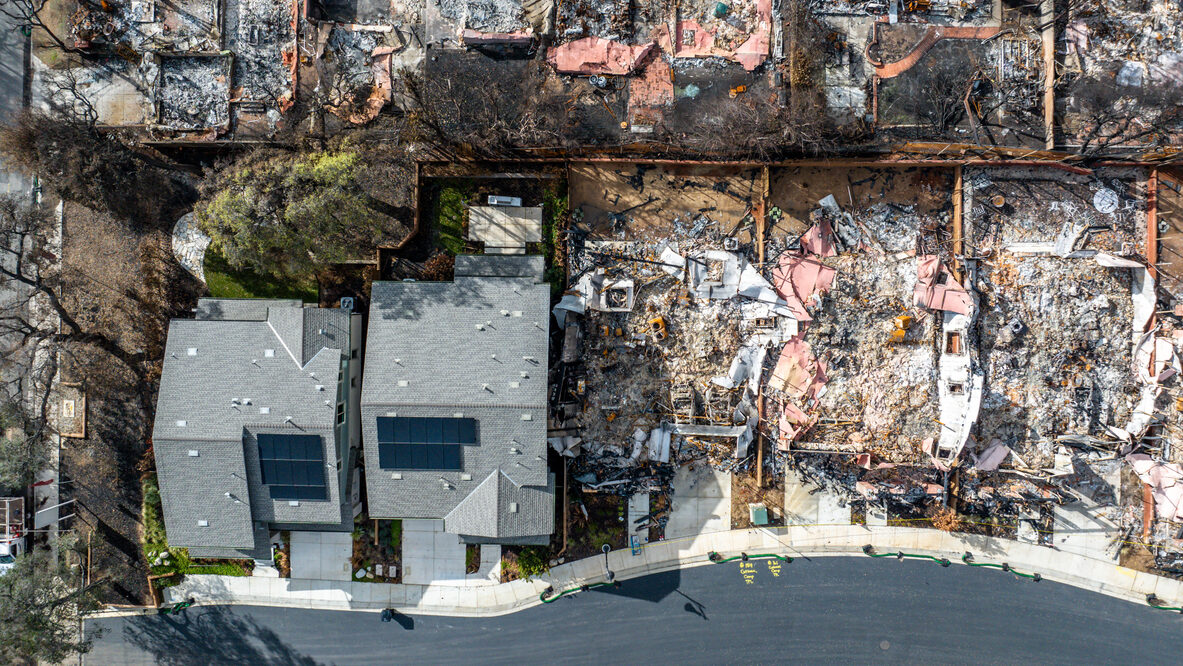
Underserved and Overlooked: Understanding Pre-Fire Economic Inequality Among Residents in Altadena, California
Introduction
The January 2025 Eaton Canyon Fire was a wildfire that burned through residential neighborhoods in Altadena, California, destroying homes and displacing hundreds of families. Even those fortunate enough not to live within the fire perimeter had their lives disrupted by evacuation orders and have been exposed to the pollutants and toxins released by the flames.1 In the wake of the disaster, many recovery efforts have focused on physical rebuilding and infrastructure. However, supporting people in navigating recovery is also extremely important. Without a clear picture of pre-fire socioeconomic conditions, it is challenging to identify which households may be most at risk of being left behind during recovery and to provide resources and assistance to those most in need.
Altadena is often viewed as a middle-class and affluent community. Altadena’s median household income of $129,0002 is more than 1.5 times the Los Angeles County median. But this top-line number hides Altadena’s economic diversity and inequality, which is as varied as that of the entire county.3 Annual income data reveal sharp divides between Altadena’s highest- and lowest-income residents. While about one in four households had an annual income of $250,000 or more in 2019-23, another quarter had household incomes under $65,000 in the same year.4 These lower-income residents may face the steepest barriers to recovery, especially if they are renters, seniors, immigrants, or working-class families; yet, they are not always visible in recovery strategies.
This factsheet uses multiple publicly available datasets to provide a snapshot of Altadena’s low-income population before the wildfire. It draws from 2019-23 American Community Survey 5-Year Data, Los Angeles County Department of Public Social Services data, California Department of Education data, and Internal Revenue Service data.5 These data sources are among the best available, but have limitations as they reflect pre-disaster conditions and do not reveal how many of these residents have since received—or been excluded from—post-fire aid and services. Still, these estimates offer an important baseline to guide equitable recovery planning by identifying the number and characteristics of the most in need.
Key Findings
Finding 1: Thousands of Altadena residents struggled to make ends meet even before the Eaton Fire.
In 2019-23, more than 7,000 Altadena residents—about one in six (18%)—had incomes below twice the Federal Poverty Line (FPL), the benchmark commonly used to determine eligibility for many public safety net programs.6 Additionally, over 3,000 Altadena residents (7%) lived below the FPL. The income threshold for living below the FPL varies by family size and is adjusted for inflation annually but was $30,000 in 2019-23 for a family of four.7 The households below the FPL were among the most financially vulnerable when disaster struck.
Finding 2: Latino residents were disproportionately represented among Altadena’s lowest-income households before the Eaton Fire.
Latino residents were overrepresented among those with the greatest financial need in Altadena before the wildfire. Latinos made up 27% of the total Altadena population in 2019-23 but accounted for 44% of Altadena residents living below the FPL (Figure 1). In contrast, white residents, who made up 42% of the population, represented just 35% of those below the FPL. Black residents accounted for 18% of the total population and 15% of those below the FPL.
The “parity index” located on the left side column of Figure 1 highlights these disparities further. A value of 1.00 on the parity index indicates proportional representation of that racial or ethnic group among the low-income population, meaning that if a group made up 20% of Altadena’s total population, 20% of that same group would be living below the FPL. Latino residents had a parity index of 1.60, meaning they were 60% more likely to be below the FPL than their share of the population would suggest (Figure 2). In comparison, both white and Black residents had parity indexes below 1.00, indicating underrepresentation among the lowest-income households.
Figure 1. Altadena, CA Total Population and Population with Income Below the Federal Poverty Line in 2019-23, by Race and Ethnicity
Note: Latinos include those who identify as Hispanic or Latino of any race.
Source: Tabulated by authors from the Census American Community Survey 2019-23 (5-Year Estimates) for the Census designated place of Altadena.
Finding 3: Participation in safety net programs shows that a portion of the Altadena community was navigating financial hardship before the Eaton Fire.
Altadena’s pre-fire rates of enrollment in core assistance programs underscore the presence of economic hardship.8 In December 2024, about 7% of Altadena’s population (over 2,700 people) received CalFresh food benefits, and about 19% (over 6,800 people) were covered by Medi-Cal, the state’s health insurance program for low-income residents (Figure 2).9 Actual need was almost certainly higher, due to language barriers, stigma, and administrative hurdles that keep many eligible families from enrolling.10 In addition, over 11% of tax filers (over 4,100 tax filers) claimed the Earned Income Tax Credit (EITC) as of 2022.11 EITC is among the largest social safety net programs in the country and gives a tax break to low-to-moderate-income workers and their families, most of whom have annual incomes below $25,000.12 These households represent the working poor: those who are economically active but with incomes too low to make ends meet. This reliance on public aid underscores how limited household resources were pre-fire and may signal greater recovery challenges for those with the fewest financial buffers.
Figure 2. Share of Altadena, CA Residents Accessing Social Assistance Programs
Source: Tabulated by authors from the U.S. Internal Revenue Service, ”Earned income and Earned Income Tax Credit (EITC) Tables, ”SOI Tax Stats – Individual Income Tax Statistics – 2022 ZIP Code Data (SOI),” available online; and the Los Angeles County, Department of Public Social Services, available online.
Finding 4: Housing costs and a lack of affordable rental options left many Altadena residents severely cost-burdened by housing even before the Eaton Fire.
Altadena’s rental market was already under pressure before the wildfire. Median gross rent in Altadena was about 20% higher than the LA County average,13 and fewer than 200 HUD-subsidized units existed in the area before the fire.14 As a result, more than a quarter of renters (28%) in Altadena were severely cost-burdened, spending half or more of their income on their housing (Figure 3). This phenomenon is not limited to renters. In the same years, 14% of homeowners were severely cost-burdened. These high costs leave little flexibility for saving and addressing other necessities. This could be especially troubling for renters recovering from the fire, as many may struggle to navigate an increasingly expensive Los Angeles rental market.
Figure 3. Share of Altadena, CA Residents Severely Cost-burdened by Housing in 2019-23
Source: Tabulated by authors from the Census American Community Survey 2019-23 (5-Year Estimates) for the Census designated place of Altadena.
Finding 5: Hundreds of low-income Altadena students and their families relied on Altadena schools for food security before the Eaton Fire.
Altadena was home to five operating schools before the wildfires: four elementary schools and one middle school.15 These schools not only educated students but also served as vital access points for daily support services for working families. There were 2,353 students enrolled across these five schools during the 2023-24 school year. Among these students, 1,111 were Latino (47%), and 1,277 were eligible for free or reduced-price lunch (54%).16 Free and reduced-price meal eligibility is determined based on varied economic vulnerabilities and circumstances, including the student’s living situation or family’s income— for instance, a family of four would qualify for reduced-price meals if they had an annual household income below $55,500.17
Losing access to school during and after the fire put many of these children in precarious situations. Today, two of Altadena’s five schools sit within the fire’s burn zone, while an additional two lie at its edge and were susceptible to smoke damage. Collectively, these schools enrolled 1,719 students in the 2023-24 school year.18 Whether the fires damaged their schools or their homes, students and their families are now being forced to navigate new systems, increasing the risk that they and their families will fall through the cracks during recovery..
Conclusion and Recommendations
This analysis paints a picture of Altadena’s hidden economic vulnerabilities. Thousands of residents—many low-income, rent-burdened, and dependent on the social safety net—were at high risk of displacement even before the fire. However, significant data gaps remain that limit our understanding of who has been most affected by the January 2025 Eaton Canyon Wildfire. Without coordinated data systems and targeted intervention, recovery efforts risk overlooking those most in need. Closing these gaps is critical not only for meeting immediate recovery needs but also for establishing the infrastructure necessary to respond to future disasters, which are expected to become more frequent and severe with a changing climate.
To ensure a more equitable post-fire recovery, we recommend the following next steps:
- Geographic Analysis of the Direct Fire Impact on Low-Income Residents: Research organizations should work with LA County to quantify who was temporarily or permanently displaced by the wildfire, and whose homes were destroyed or damaged, to better understand the services needed for low-income Altadena residents.
- Snapshots on Post-Fire Recovery Outcomes and Challenges: Research organizations should work with LA County and local non-profit stakeholders to better identify post-fire needs and challenges faced by different demographics of low-income Altadena residents. This could include quantitative and qualitative analysis on the problems residents face in finding replacement housing (for both homeowners and renters), accessing recovery support services, overcoming the financial cost of displacement, managing disruption to employment and small businesses, or getting students re-enrolled and academically re-adjusted.
- An Inter-Agency and University Data Collaborative: Government stakeholders such as LA County agencies (DPSS, Assessor, Planning, Public Health), Pasadena Unified School District (PUSD), and the Los Angeles Unified School District (LAUSD) should partner with local university research organizations to develop a longitudinal cross-system database on recovery trajectories and outcomes. The database can and should build upon the research produced by recommendations 1 and 2 above.
- Targeted and Adaptive Recovery Programs: LA County should leverage the findings of this research and data developed through recommendations 1-2 to prioritize and target recovery efforts for the most at-risk populations in Altadena. For instance, the county could use the data to work with nonprofits to set up dedicated support for finding affordable replacement housing for households that were and continue to be severely housing cost-burdened post-fire. Additionally, PUSD and LAUSD could work with the state to provide stipends or free meal access to better support low-income students.
References
1 See for example, Eaton Fire Residents United, “Eaton Fire Contamination Map,” accessed on May 19, 2025, available online.
2 Based on 2019-23 American Community Survey 5-Year Data, prepared by Social Explorer, accessed May 11, 2025, available online. The median household income in Altadena census designated place (CDP) is over $135,000, if adjusted to 2025 dollars.
3 The Gini index for Altadena was 0.47 and 0.50 for L.A. County. This index measures the level of inequality in the distribution of income for a given population, with values ranging between 0 (perfect equality) to 1 (perfect inequality).
4 The top income bracket in the 2019-23 American Community Survey 5-Year Dataset is $200,000 or more, and 32.5% of Altadena’s household fell into this category.
5 Some of the data used for calculating percentages in this analysis use total population counts from the Altadena ZIP code tabulation area (91001), while some use total population counts for the Altadena census designated place (CDP). According to the 2019-23 American Community Survey 5-Year Data, Altadena had a total population count of CDP 41,921. However, Altadena had a total population of 36,402 according to the ZIP code tabulation area (91001). When calculating percentages, we used the population total most appropriately associated with the respective counts of the economically disadvantaged. We have added footnotes throughout the brief indicating which total population count was used for each percentage.
6 Authors’ analysis from the Census ACS 2019-23 (5-Year Estimates) for the Census Designated Place of Altadena; Monica Saucedo and Nishi Nair, “California’s Safety Net Explained” (California Budget & Policy Center, Sacramento, January 2025), available online.
7 U.S. Department of Health and Human Services, “HHS Poverty Guidelines for 2025,” accessed May 11, 2025, available online.
8 Los Angeles County Department of Public Social Services, “DPSS At-A-Glance,” updated April 2025, available online.
9 Both CalFresh and Medi-Cal percentages calculated using the 2019-23 total population count for the Altadena ZIP code tabulation area. See footnote 5 for more details.
10 See for example: Los Angeles County Department of Public Social Services, “CalFresh Eligibility Criteria,” accessed on May 11, 2025, available online; Covered California, “Program Eligibility by Federal Poverty Level for 2025,”accessed on May 11, 2025, available online; and Energy Star, “Am I Eligible for Assistance?”, accessed on May 11, 2025, available online.
11 EITC filer percentage calculated using the 2019-23 Altadena ZIP code total population counts. See footnote 5 for more details.
12 U.S. Internal Revenue Service, ”Earned Income and Earned Income Tax Credit (EITC) Tables,”, accessed May 11, 2025, available online; U.S. Internal Revenue Service, ”SOI Tax Stats – Individual Income Tax Statistics – 2022 ZIP Code Data (SOI),” available online.
13 Based on 2019-23 American Community Survey, prepared by Social Explorer, accessed May 11, 2025. The median household income is over $135,000 if adjusted to 2025 dollars.
14 U.S. Department of Housing and Urban Development, “Assisted Housing: National and Local,” accessed May 11, 2025, available online.
15 Authors’ analysis of California Department of Education, “Annual Enrollment Downloadable Files,” accessed on May 20, 2025, available online and Cal Fire, “Eaton Fire,” accessed on May 21, 2025, available online. Altadena schools were defined as those located within the 91001 ZIP code, which was used as a proxy for Altadena. The four elementary schools are School Altadena Elementary, Mary W. Jackson STEAM Multilingual Magnet Elementary, Odyssey Charter School South, and Odyssey Charter. The middle school is Charles W. Eliot Middle. All five schools were operating during the 2023-24 school year, prior to the Eaton Fire in January 2025.
16 Authors’ analysis of California Department of Education, “California Longitudinal Pupil Achievement Data System (CALPADS),” accessed on May 20, 2025, available online; “Free or Reduced-Price Meal (Student Poverty) Data Files” and “Annual Enrollment Downloadable Files,” both accessed on May 20, 2025, available online.
17 Students qualify for free or reduced-price meals because they meet at least one of these conditions: 1) their family filled out a National School Lunch Program application; 2) their family turned in an alternative household-income form; 3) they are listed in CALPADS as homeless, migrant, or tribal foster youth; 4) CALPADS shows they get CalFresh (food stamps) or CalWORKs benefits;d or 5) they appear in CALPADS’ weekly foster-care match as living in foster placement, foster family maintenance, or tribal foster care. For more data on income qualifications, review the California Department of Education, Income Eligibility Scales for School Year 2023–24, available online.
18 Authors’ analysis of California Department of Education, “Annual Enrollment Downloadable Files,” accessed on May 20, 2025, available online and Cal Fire, “Eaton Fire,” accessed on May 21, 2025, available online. Charles W. Eliot Middle and Odyssey Charter School South were both within the fire perimeter and damaged by the disaster. Altadena Elementary and Odyssey Charter, were right on the edge of the fire perimeter.
Acknowledgments
This data brief was made possible through the generous support of JPMorgan Chase Global Philanthropy, James Irvine Foundation, the California State Legislature, and the California Latino Legislative Caucus to develop timely research that informs domestic policy challenges impacting Latinos and other communities of color. Additional support provided by the Center for Neighborhood Knowledge. The authors are grateful for the technical support from Citlali Tejeda; and communications support from Alberto Lammers and Cris Rivera.
About our Centers
The UCLA Latino Policy and Politics Institute addresses the most critical domestic policy challenges facing Latinos and other communities of color through research, advocacy, mobilization, and leadership development to expand genuine opportunities for all Americans.
The UCLA Center for Neighborhood Knowledge specializes in empirical spatial analysis to inform policy and planning action and explicitly emphasizes the study of immigrant enclaves, low-income neighborhoods, and ethnic minority communities.
The UCLA Latino Policy and Politics Institute and the Center for Neighborhood Knowledge acknowledge the Gabrielino Tongva peoples as the traditional land caretakers of Tovaangar (the Los Angeles basin and So. Channel Islands). As a land grant institution, we pay our respects to the Honuukvetam (Ancestors), ‘Ahiihirom (Elders), and ‘Eyoohiinkem (our relatives nations) past, present, and emerging.
Disclaimer
The views expressed herein are those of the authors and not necessarily those of the University of California, Los Angeles, as a whole. The authors alone are responsible for the content of this report.
For More Information Contact:
Alberto Lammers, alammers@luskin.ucla.edu.












